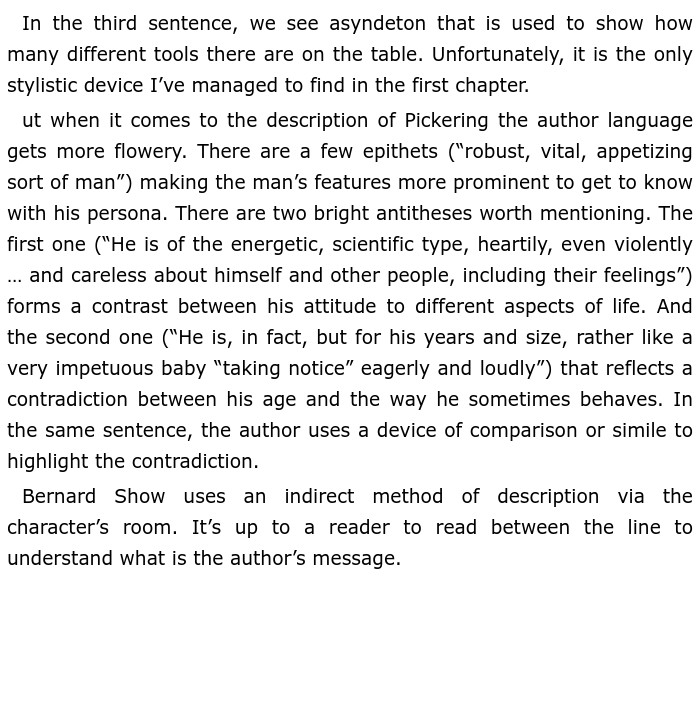|
Вы здесь: Критика24.ру › Английская Литература
Анализ отрывка из произведения «Пигмалион» Бернарда Шоу «Next day at 11 a.m. Higgins's laboratory in Wimpole Street...» (Английская Литература)The text I am going to analyze is an extract from Bernard Show’s novel titled “Pygmalion”. In my opinion, the main idea of the passage is to represent how a detailed description of someone’s place of living reflects the peculiarities of a personal life. Everything we have in our house, flat or room in its combination sometimes can tell about us even more than we. The meaning of the title is not connected with this certain passage. The composition of the text does not vary greatly. The major piece of it represents a detailed picture of Higgin’s laboratory. The only paragraph that stands out is the last one since the description turns to a person. As far as I understand the narration goes through the mouth of the author outside the story so his participation in the story is minimized. The events take place in Higgin’s laboratory in Wimpole Street. There is not any reference to what period they go in. I think that the settings of the passage can be easily changed without any ruinous effect. Certainly, the description would be extremely different because we can hardly find two alike rooms in the world. Even if people sometimes buy the same furniture or follow the same designer’s plans, throughout their living in it they leave their marks on it. It is not only about the things they buy, but alsohowh they do their household chores because the conditions in which the furniture is held are also rather informative. The extract starts with the description of Higgin’s laboratory. The narrator goes slowly paying attention to various details. The last paragraph introduces the character of Pickering sitting at the table. Here go a few sentences that bring forward both his character traits and life aspects. Theoretically, this extract can be divided into two parts due to the change of the object of description. They can be titled “Higgin’s laboratory” and “Pickering” according to their objects. The first one covers the major part of the text, while the last one there is only the last paragraph devoted to. Both the key mood of the text and the language used by the author is quite unemotional or even dry except for the last paragraph. That’s why it is not as rich in the stylistic devices as the previous extracts are.  Judging from the medical tools lying on the table, it is clear that here works a man of science. He is rather an intelligent person whose interests varies from playing musical instruments to observing wonderful engravings. He is an aesthete who enjoys such a beautiful detail at a plateful of fruits and chocolates on the piano. It seems that everything in this room lays where it has to so I guess this person cares for his workplace. However, when the character of Pickering appears in the last paragraph the author turns to a direct method of description. Though Pickering seems to be a serious man being dresses in a professional-looking black-frockcoat he is being compared to an over-curious child who should be looked after to keep him from making trouble. As a scientist, he tends to listen to his mind but not his heart. Any expression of people is sort of foolishness for him. Undoubtedly, Bernard Shaw has managed to convey his characters’ features via the use of indirect methods of description. It proves the way of opening characters to a reader is not limited only to its’ appearance because sometimes even his possession tells us more than his face or speech. I am wondered at the mastery of the writer who brilliantly buses so special methods of narration. Обновлено: Опубликовал(а): Genium23 Внимание! Спасибо за внимание. Полезный материал по теме
И это еще не весь материал, воспользуйтесь поиском
|
|


